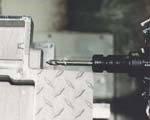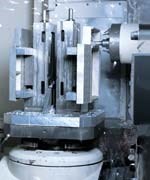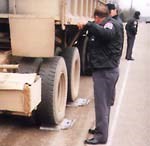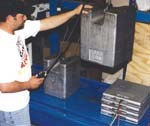Weighing The HMC's Pluses
A horizontal machining center enabled this scale manufacturer to get its machining department back into shape.
Share





When a bottleneck in the machining department prevents an increase in production, the usual response is to add one or more of the same kind of machine tool the firm is currently using. Sometimes, however, the better solution is to buy a different kind of machine tool. That was the case for Intercomp Co., a Minneapolis manufacturer of high capacity scales: Faced with the need to increase machining capacity, the firm bought a horizontal machining center—its first—instead of increasing its battery of vertical machining centers. The HMC not only broke the bottleneck but cleared up a number of other problems for the machining department as well.
You probably have never purchased an Intercomp scale, and you probably cannot recall ever having seen one in anyone's bathroom. That's because the company's scales are used to weigh vehicles instead of people. Law enforcement officers use Intercomp scales to determine whether 18-wheelers are over the weight limit. Trucking companies also use the scales to make sure that the loads their trucks are carrying do not exceed the maximum allowable limit.
Planes must be weighed periodically as part of their scheduled maintenance to ensure that their centers of gravity haven't shifted. A 747 commercial jet can accumulate up to 600 to 1,000 pounds of dirt and moisture between weighings, which can affect the way it flies and handles. Aircraft are also weighed before and after major repairs (presumably to ensure that any parts that were removed were put back or replaced).
Intercomp scales are also used to "set up" the chassis of racing cars, that is, to properly distribute and balance the cars' corner weights to optimize performance. Other major markets include agricultural equipment and the military.
A single scale can be used to weigh an individual wheel, an axle or an axle group. Typically, however, multiple scales are used to weigh a vehicle. For example, six scales may be used to weigh a truck, and 18 to weigh a Boeing 747 aircraft. The scales are connected by interconnect cables to provide a fast total weight measurement. A notebook computer loaded with data-collection software is available as an option, as is a printer that connects to the scales via a cable to provide printouts of the measurements.
The scales are easy to use. Simply place them ahead of the wheels, roll the vehicle onto them, stop, take the readings, and roll off. The scales are highly accurate and repeatable.
The scale is made up of three major components: a base, a platform and a load cell. Most of the bases and platforms are made from aircraft aluminum. Other materials are used, however, depending on the application.
Intercomp's business has grown in recent years. The firm has done so well, in fact, that capacity problems began to surface. The firm machines all of the housings for its scales in house. For some models, the base is an aluminum casting that must be faced and then drilled and tapped on several sides. For most models, however, the base is machined from aluminum plate or billet, which involves hollowing out the cavity in addition to the above operations.
Until recently, all of the bases and platforms were machined on the shop's five vertical machining centers. Intercomp makes its scales in many models. In the past, it made the scales to order, but the need to fill orders faster to stay competitive dictated being able to ship immediately from inventory. Accordingly, the firm's production is geared to maintaining about one month's inventory of all models. That means that in any given period the company produces most of its scale models in relatively small batches.
Run, Flip, Run, Flip
"All of our housings require machining on multiple sides, so machining them on the vertical machining centers involves run, flip, run, flip," explains plant manager Jeff Weyandt. "Our ability to turn out parts was limited by the amount of time required to machine one side, turn the part, machine the next side, and so forth. The frequent changeovers from one small batch to another made for a lot of idle time on the machines, but more importantly it limited our production."
Despite efforts to increase its production (mandatory overtime, temporary help and so forth), the machining department continued to fall behind. Making matters worse, the firm had three large orders coming due at the same time. There were two choices: Either the firm had to increase its machining capacity, or it had to farm out some of the work.
In the past, when the firm needed additional machining capacity, it simply bought another vertical machining center. This time, it wanted a machine capable of cranking out parts faster. It wanted a machine that did not have to sit idle while parts were being loaded and unloaded. And it wanted a machine capable of machining multiple sides of a part so that the part could be completely machined in one setup.
The Answer Was Yes
"We had seen horizontal machining centers at machine tool shows, producing parts like ours at eye-opening rates and were confident that such a machine would solve our capacity problem, particularly in the machining of our more complicated parts," explains Intercomp's Brad Brand. "We asked ourselves if we really needed the capabilities of such a machine, and if we really needed to spend the money. We agreed that the answer to both questions was yes."
After evaluating the horizontal machining centers available on the market, Intercomp narrowed its search to the M-H4B/20 horizontal machining center available from Mitsubishi Heavy Industries America, Inc.'s Machine Tool Division in Addison, Illinois. The company purchased the machine from Hales Machinery, a Minneapolis-based machine tool distributor.
The M-H4B/20 is designed for durability and thermal stability. Its bed and column are cast iron, and the column is symmetrically designed about the machine's X axis, making for a thermally symmetrical configuration. Slideway covers in front of the column and troughs at both sides of the bed prevent heat transfer to the column from the cutting fluid and/or chips. The machine has a 30-hp spindle motor capable of spindle speeds up to 12,000 rpm. It offers cutting feed rates up to 1,575 ipm.
The machine's automatic tool changer accommodates 40 tools and boasts a 1.3-sec. tool-change time. (Chip-to-chip time is 4.0 seconds.) The toolchanger has an optional learning feature that enables the operator to load tools into the changer in random order and without regard to placement. The ATC automatically rearranges the tools for greatest toolchanging efficiency as it goes through machining of the first piece.
One of the most important features of the machine for Intercomp is an automatic pallet change system that allows the operator to load/unload parts on one pallet while parts fixtured on the other pallet are being machined. With the system, machining on the HMC can be continuous except for the 6 seconds it takes the machine to swap pallets. The pallet can be indexed 360 degrees (2.5 seconds per 90 degrees), enabling all four sides of a part to be machined in one setup.
Delivered On Time
By the time the HMC was up and running at Intercomp, the company was 3 weeks behind schedule in the production of the large scale orders mentioned earlier. Work was gradually shifted from the verticals to the more productive horizontal machine, enabling all of the orders to be delivered on time. "In order to make our delivery dates, we would run the same job on three or four of our VMCs at the same time," explains Mr. Weyandt. "As soon as the horizontal machine came on-stream, we slid that work onto it, so it was actually doing the work of three or four of the VMCs."
The part shown being machined in the photos, a cast aluminum base for Intercomp's Model PT300 high-capacity (up to 20,000 pounds) wheel load scale, is typical in terms of the drilling and tapping required on multiple sides. Two castings are fixtured on the "idle" pallet (photo at top of this article) while two castings fixtured on the "working" pallet are being machined. In this case, three sides of the casting are machined. The close-up of the working pallet in the machining area shows the top surface of one of the bases being machined. The pallet indexes to present the front face and two sides of each casting to the spindle for machining. (The close-up on page 66 shows the pallet indexed 90 degrees for drilling of the side of the casting.)
When Intercomp machined the PT300 base on its VMCs, the best rate it could achieve was 2 parts per hour. The company is now machining the part on the HMC at a rate of 12 per hour—a 600 percent increase.
In addition to the HMC's ability to machine multiple sides of a part in one setup, it provides dramatically higher metal removal rates, which is a major consideration for scale bases machined from the solid, where the cavity must be milled. "Our most powerful VMC had a machining feed rate of about 140 ipm running at 10,000 rpm with a 0.250-inch depth of cut," explains Mr. Brand. "By switching to a different cutter, we were able to increase the machining rate to 180 ipm.
"When we switched the job to the HMC, we were able to increase the feed to 800 ipm using the same cutter," Mr. Brand continues. "Then the cutter broke—the machine was too powerful for it. We switched to a heavier duty cutter and were able to boost the cutting rate to 1,100 ipm using a 0.313-inch depth of cut."
The heavier metal removal rate provides a major productivity boost at Intercomp since most of its scale bases are machined from the solid. A case in point is the base for the company's LP600 high-capacity wheel load scale. The base measures 16 inches by 23 inches and is machined from a 1 ¼-inch-thick piece of 6061 aircraft alloy aluminum plate.
Why machine from the solid? In the first place, production quantities may not justify the cost of casting dies. "Machining from the solid also makes for a stronger part," Intercomp's Mr. Brand stresses. "Machining the part from plate helps us avoid flatness as well as porosity problems. It also provides a better finish.
"Before, it took us 52 minutes on a vertical machining center to mill the cavity and machine the sides of the LP600 base," Mr. Brand continues. "Now, we machine the part on the HMC in 15 minutes—that's about a 300 percent improvement."
Here are a few more comparisons involving parts machined from the solid: Before, Intercomp machined two sides of 10-inch by 10-inch pads for its E-Z Weigh (Go)Kart Scale on its VMCs at a rate of two per hour. Now, it machines them on the HMC at a rate of 16 per hour. Before, the company machined three sides of 15 inch by 15 inch pads for its SW series scales on its VMCs at a rate of six per hour. Today, it's knocking out 16 per hour on its HMC.
With such productivity improvements, it is not hard to understand how Intercomp was able to cut back from a mandatory overtime schedule for the machining department to regular hours. The company not only saved overtime costs but also eliminated having to periodically add temporary help.
Shifting most of the complicated machining to the HMC has increased the productivity of the VMCs. Now they are used primarily to machine simpler parts that require few if any setup changes. As a result, throughput on these machines has improved as well.
Because the HMC machines the parts complete—or nearly complete—in one setup, multiple handlings have been eliminated. There are fewer queues at the machines, and work-in-process costs have been reduced. Opportunities for human error created by multiple handlings have also been eliminated, leading to fewer rejects. Best of all, the additional capacity provided by the HMC has made it easier for Intercomp to maintain its production schedule, even when unexpected orders come in. Without the HMC, the company probably would have had to go to a second shift, with all the cost that entails, to keep up with orders.
The one HMC will meet Intercomp's machining requirements for the foreseeable future—it currently accounts for between 20 percent and 30 percent of total machining. Down the road, however, the firm sees the possibility of replacing two of its VMCs with still another HMC.
Related Content
How to Mitigate Chatter to Boost Machining Rates
There are usually better solutions to chatter than just reducing the feed rate. Through vibration analysis, the chatter problem can be solved, enabling much higher metal removal rates, better quality and longer tool life.
Read MoreCNC Machine Shop Honored for Automation, Machine Monitoring
From cobots to machine monitoring, this Top Shop honoree shows that machining technology is about more than the machine tool.
Read MoreLean Approach to Automated Machine Tending Delivers Quicker Paths to Success
Almost any shop can automate at least some of its production, even in low-volume, high-mix applications. The key to getting started is finding the simplest solutions that fit your requirements. It helps to work with an automation partner that understands your needs.
Read MoreHow to Successfully Adopt Five-Axis Machining
While there are many changes to adopt when moving to five-axis, they all compliment the overall goal of better parts through less operations.
Read MoreRead Next
Registration Now Open for the Precision Machining Technology Show (PMTS) 2025
The precision machining industry’s premier event returns to Cleveland, OH, April 1-3.
Read More5 Rules of Thumb for Buying CNC Machine Tools
Use these tips to carefully plan your machine tool purchases and to avoid regretting your decision later.
Read MoreSetting Up the Building Blocks for a Digital Factory
Woodward Inc. spent over a year developing an API to connect machines to its digital factory. Caron Engineering’s MiConnect has cut most of this process while also granting the shop greater access to machine information.
Read More











.jpg;width=700;quality=80)






















